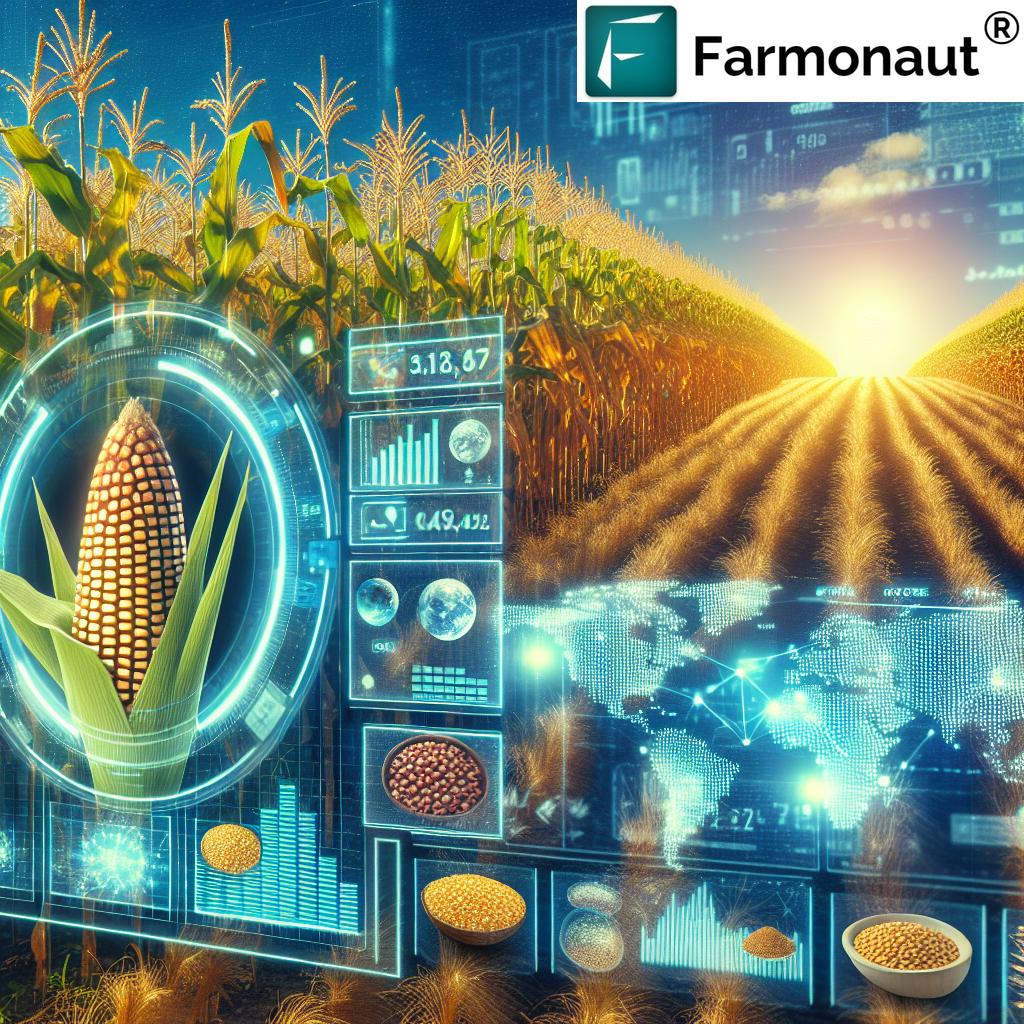Revolutionizing Northeast Agriculture: How GIS and Ecosystem Services Are Shaping Sustainable Farming Practices
“The Northeast US agriculture policy assessment examined over 1,300 programs and policies across 11 states and Washington D.C.”
In the ever-evolving landscape of agriculture, we find ourselves at the cusp of a revolutionary transformation in the Northeast United States. The intersection of Geographic Information Systems (GIS) and ecosystem services is reshaping the way we approach sustainable farming practices, heralding a new era of agricultural productivity and environmental stewardship. As we delve into this comprehensive report on Northeast US agriculture policy, we uncover the intricate web of programs and policies that are steering the region towards a more sustainable and technologically advanced future.
The Landscape of Northeast Agriculture
The Northeast region, comprising eleven states and the District of Columbia, stands as a testament to the diversity and resilience of American agriculture. From the rolling hills of Pennsylvania to the coastal plains of Maine, this region encompasses a rich tapestry of agricultural landscapes, each with its unique challenges and opportunities.
Our analysis of over 1,300 programs and policies reveals a concerted effort to enhance ecosystem services on working lands. These initiatives span a wide range of focus areas, including:
- Soil health management
- Water quality conservation
- Biodiversity preservation
- Carbon sequestration
- Precision agriculture adoption
The sheer number of programs underscores the region’s commitment to sustainable agriculture and environmental conservation. However, it also highlights the complexity of the policy landscape that farmers, extension professionals, and policymakers must navigate.
GIS: The Cornerstone of Modern Agricultural Management
At the heart of this agricultural revolution lies Geographic Information Systems (GIS), a powerful tool that is transforming the way we understand and manage agricultural landscapes. GIS in agriculture enables us to:
- Map and analyze soil types and conditions
- Monitor crop health and yield potential
- Optimize resource allocation and management
- Track changes in land use and ecosystem health over time
The integration of GIS technologies into agricultural practices is not just enhancing productivity; it’s fundamentally changing how we approach ecosystem services in agriculture. By providing precise, data-driven insights, GIS empowers farmers and policymakers to make informed decisions that balance agricultural productivity with environmental conservation.
Ecosystem Services: The Backbone of Sustainable Farming
Ecosystem services in agriculture represent the myriad benefits that natural ecosystems provide to support agricultural production and environmental health. In the Northeast, these services are increasingly recognized as critical components of sustainable farming practices. Key ecosystem services include:
- Pollination by native insects
- Natural pest control
- Soil formation and nutrient cycling
- Water purification and regulation
- Carbon sequestration in soils and vegetation
Our report highlights the growing emphasis on integrating these services into agricultural land management strategies across the Northeast. By fostering practices that enhance ecosystem services, farmers are not only improving their land’s productivity but also contributing to broader environmental goals.
Sustainable Farming Practices: A Paradigm Shift
The adoption of sustainable farming practices is at the core of the Northeast’s agricultural transformation. These practices aim to maintain or enhance ecosystem services while ensuring economic viability for farmers. Some key sustainable farming practices gaining traction in the region include:
- Cover cropping to improve soil health and reduce erosion
- Precision agriculture to optimize resource use
- Integrated pest management to reduce reliance on chemical pesticides
- Agroforestry to enhance biodiversity and carbon sequestration
- Conservation tillage to preserve soil structure and organic matter
These practices are not only enhancing the resilience of agricultural systems but also contributing to the region’s climate change mitigation efforts.

The Role of Agricultural Extension Programs
Agricultural extension programs play a pivotal role in bridging the gap between research and practical implementation on farms. In the Northeast, these programs are evolving to meet the changing needs of farmers in the digital age. Key aspects of modern extension programs include:
- Virtual conferencing and online courses for continuous education
- Hands-on training in GIS and precision agriculture technologies
- Collaborative networks for knowledge sharing among farmers
- Mentoring programs to support new and transitioning farmers
These initiatives are crucial in ensuring that the latest sustainable farming practices and technologies reach farmers across the region, regardless of their farm size or location.
Precision Agriculture: The Future of Farming
Precision agriculture technologies are revolutionizing farm management in the Northeast. By leveraging GIS, remote sensing, and IoT devices, farmers can now:
- Apply inputs with pinpoint accuracy
- Monitor crop health in real-time
- Predict and mitigate potential issues before they escalate
- Optimize irrigation and fertilization schedules
These technologies not only improve farm productivity but also contribute to environmental conservation by reducing resource waste and minimizing the environmental footprint of agricultural operations.
“GIS and ecosystem services are revolutionizing sustainable farming practices in the Northeast, focusing on soil health and precision agriculture.”
Agri-environmental Incentives: Aligning Economics with Ecology
A critical component of the Northeast’s agricultural policy landscape is the implementation of agri-environmental incentives. These programs aim to encourage farmers to adopt practices that enhance ecosystem services by providing financial support and technical assistance. Key incentive programs include:
- Payments for ecosystem services (PES)
- Conservation easements
- Cost-sharing for implementing sustainable practices
- Tax incentives for land conservation
By aligning economic incentives with ecological goals, these programs are helping to accelerate the adoption of sustainable farming practices across the region.
Soil Health Management: The Foundation of Sustainable Agriculture
Soil health is increasingly recognized as the cornerstone of sustainable agriculture. In the Northeast, soil health management is receiving significant attention, with programs focusing on:
- Enhancing soil organic matter content
- Improving soil structure and water-holding capacity
- Promoting beneficial soil microorganisms
- Reducing soil erosion and compaction
These efforts not only improve agricultural productivity but also contribute to carbon sequestration, water quality improvement, and overall ecosystem resilience.

Working Lands Conservation: Balancing Production and Protection
The concept of working lands conservation is gaining traction in the Northeast, recognizing that agricultural lands can simultaneously support food production and environmental conservation. This approach involves:
- Implementing conservation practices on actively farmed land
- Creating wildlife corridors and habitat patches within agricultural landscapes
- Promoting diverse crop rotations and intercropping
- Integrating natural and semi-natural elements into farm design
By adopting these strategies, farmers are contributing to landscape-level conservation efforts while maintaining productive agricultural operations.
The Role of Technology in Modern Agriculture
Technology is playing an increasingly vital role in shaping sustainable farming practices in the Northeast. From satellite-based crop monitoring to AI-driven advisory systems, innovative tools are empowering farmers to make data-driven decisions. Farmonaut, a leading agricultural technology company, offers advanced satellite-based farm management solutions that exemplify this technological revolution.
Key technological advancements include:
- Remote sensing for crop health monitoring
- AI-powered crop yield prediction
- Blockchain-based traceability systems
- Automated irrigation and fertilization systems
These technologies not only enhance farm productivity but also contribute to more efficient resource use and reduced environmental impact.
Regional Collaboration and Knowledge Sharing
The success of sustainable farming initiatives in the Northeast relies heavily on regional collaboration and knowledge sharing. Our report highlights the importance of:
- Cross-state cooperative extension programs
- Regional research networks focused on ecosystem services
- Collaborative policy development among Northeast states
- Farmer-to-farmer mentoring and knowledge exchange platforms
These collaborative efforts ensure that best practices and innovations are disseminated effectively across the region, accelerating the adoption of sustainable farming practices.
The Economic Impact of Ecosystem Services
Recognizing and valuing ecosystem services is crucial for sustainable agricultural development. Our analysis reveals that enhancing ecosystem services can have significant economic benefits, including:
- Reduced input costs through natural pest control and pollination
- Improved crop yields through enhanced soil health
- New revenue streams from carbon credits and payments for ecosystem services
- Increased resilience to climate change and extreme weather events
By quantifying these benefits, policymakers and farmers can make more informed decisions about land management and conservation practices.
The Future of Northeast Agriculture
As we look to the future, the integration of GIS, ecosystem services, and sustainable farming practices will continue to shape Northeast agriculture. Key trends to watch include:
- Increased adoption of precision agriculture technologies
- Greater emphasis on carbon sequestration in agricultural soils
- Expansion of agri-environmental incentive programs
- Development of climate-resilient farming systems
These trends suggest a future where agriculture not only feeds the region but also plays a crucial role in environmental conservation and climate change mitigation.
Comparative Analysis of Ecosystem Services in Northeast Agriculture
| State/Region | Number of Programs/Policies | Primary Ecosystem Services Focus | GIS Implementation Level | Sustainable Farming Practices Adoption Rate (%) | Economic Impact (Estimated Annual Value in millions USD) | Environmental Benefits Score (1-10 scale) |
|---|---|---|---|---|---|---|
| Massachusetts | 120 | Soil Health, Water Quality | High | 65 | 250 | 8 |
| Connecticut | 95 | Water Quality, Biodiversity | Medium | 58 | 180 | 7 |
| Maine | 110 | Forest Management, Soil Health | Medium | 62 | 200 | 8 |
| New Hampshire | 85 | Water Quality, Carbon Sequestration | Medium | 55 | 150 | 7 |
| Vermont | 100 | Soil Health, Biodiversity | High | 70 | 175 | 9 |
| New York | 150 | Water Quality, Soil Health | High | 68 | 500 | 8 |
| Pennsylvania | 140 | Soil Health, Nutrient Management | High | 64 | 450 | 8 |
| New Jersey | 90 | Water Quality, Urban Agriculture | Medium | 60 | 200 | 7 |
| Delaware | 75 | Water Quality, Pollinator Health | Medium | 56 | 125 | 6 |
| Maryland | 105 | Water Quality, Soil Health | High | 62 | 300 | 8 |
| West Virginia | 80 | Soil Health, Forest Management | Low | 50 | 100 | 6 |
| District of Columbia | 50 | Urban Agriculture, Green Infrastructure | Medium | 45 | 50 | 5 |
Leveraging Technology for Sustainable Agriculture
In the rapidly evolving landscape of Northeast agriculture, leveraging cutting-edge technology is crucial for implementing sustainable farming practices effectively. Farmonaut offers a range of tools and services that align perfectly with the region’s focus on precision agriculture and ecosystem services enhancement.
Key technological solutions include:
- Satellite-Based Crop Monitoring: Utilize advanced satellite imagery to track crop health, soil moisture, and other vital metrics.

- AI-Driven Advisory Systems: Access personalized farm management recommendations based on real-time data and expert insights.
- Precision Resource Management: Optimize irrigation, fertilization, and pest control practices using data-driven approaches.
- Carbon Footprint Tracking: Monitor and reduce environmental impact through advanced carbon footprinting tools.
For developers and researchers looking to integrate these technologies into their own systems, Farmonaut offers comprehensive API access. Explore the API and API Developer Docs for more information.
Mobile Solutions for On-the-Go Farm Management
Modern farmers need access to critical information and tools wherever they are. Farmonaut’s mobile applications bring the power of satellite-based farm management directly to your smartphone:
Conclusion: A Sustainable Future for Northeast Agriculture
As we conclude our exploration of how GIS and ecosystem services are revolutionizing Northeast agriculture, it’s clear that we stand at the threshold of a new era in farming. The integration of advanced technologies, sustainable practices, and ecosystem-centric policies is creating a more resilient, productive, and environmentally friendly agricultural sector.
Key takeaways include:
- The critical role of GIS in informing data-driven agricultural decisions
- The growing recognition of ecosystem services as integral to sustainable farming
- The importance of regional collaboration and knowledge sharing
- The potential for technology to drive significant improvements in farm productivity and sustainability
As we move forward, continued investment in research, technology adoption, and policy development will be crucial to realizing the full potential of these innovative approaches. By embracing these changes, the Northeast is positioning itself as a leader in sustainable agriculture, setting an example for regions around the world.
Farmonaut Subscriptions
Frequently Asked Questions
Q: What are ecosystem services in agriculture?
A: Ecosystem services in agriculture refer to the benefits provided by natural ecosystems that support agricultural production and environmental health. These include pollination, pest control, soil formation, water purification, and carbon sequestration.
Q: How does GIS contribute to sustainable farming practices?
A: GIS helps in mapping and analyzing soil types, monitoring crop health, optimizing resource allocation, and tracking changes in land use. This enables farmers to make data-driven decisions that balance productivity with environmental conservation.
Q: What are some examples of sustainable farming practices in the Northeast?
A: Examples include cover cropping, precision agriculture, integrated pest management, agroforestry, and conservation tillage. These practices aim to enhance soil health, reduce environmental impact, and improve long-term farm productivity.
Q: How do agri-environmental incentives work?
A: Agri-environmental incentives are programs that provide financial support or technical assistance to farmers who adopt practices that enhance ecosystem services. These can include payments for ecosystem services, conservation easements, and cost-sharing for implementing sustainable practices.
Q: What role does technology play in modern Northeast agriculture?
A: Technology, such as satellite-based crop monitoring, AI-driven advisory systems, and precision agriculture tools, helps farmers optimize resource use, monitor crop health, and make informed decisions. This leads to improved productivity and reduced environmental impact.














